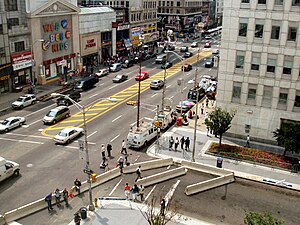News media
From Wikipedia, the free encyclopedia.

The news media is a term used to describe mass media that focus on news. These include print media (newspapers, magazines); broadcast media (radio stations, television stations, television networks), and increasingly Internet-based media (World Wide Web pages, weblogs).
Usually the term includes all working journalists and is often used by those who would make generalizations about the product of "most" journalists, for example that journalists who work for large media corporations, or who are based in New York City or Washington, D.C, harbor a liberal (or conservative) bias.
See also mass media.
Contents |
Broadcasting
Broadcasting is the distribution of audio and video signals (programs) to a number of recipients ("listeners" or "viewers") that belong to a large group. This group may be the public in general, or a relatively large audience within the public. Thus, an Internet channel may distribute text or music world-wide, while a public address system in (for example) a workplace may broadcast very limited ad hoc soundbites to a small population within its range.
The sequencing of content in a broadcast is called a schedule.
Television and radio programs are distributed through radio broadcasting or cable, often both simultaneously. By coding signals and having decoding equipment in homes, the latter also enables subscription-based channels and pay-per-view services.
A broadcasting organisation may broadcast several programs at the same time, through several channels (frequencies), for example BBC One and Two. On the other hand, two or more organisations may share a channel and each use it during a fixed part of the day. Digital radio and digital television may also transmit multiplexed programming, with several channels compressed into one ensemble.
When broadcasting is done via the Internet the term webcasting is often used.
Broadcasting forms a very large segment of the mass media.
Broadcasting to a very narrow range of audience is called narrowcasting.
Newsmagazines

A newsmagazine, sometimes called news magazine, is a usually weekly magazine featuring articles on current events. News magazines generally go a little more in-depth into stories than newspapers, trying to give the reader an understanding of the context surrounding important events, rather than just the facts.
Major news magazines in the United States include:
Major news magazines based outside the United States include:
Newspapers
A newspaper is a lightweight and disposable publication (more specifically, a periodical), usually printed on low-cost paper called newsprint. It may be general or special interest, and may be published daily, weekly, biweekly, monthly, bimonthly, or quarterly.
General-interest newspapers are usually journals of current news on a variety of topics. Those can include political events, crime, business, sports, and opinions (either editorials, columns, or political cartoons). Many also include weather news and forecasts. Newspapers increasingly use photographs to illustrate stories; they also often include comic strips and other entertainment, such as crosswords.
Newsreels
A Newsreel is a documentary film that is regularly released in a public presentation place containing filmed news stories.
Created by Pathé Frères of France in 1908, this form of film was a staple of the typical North American, British, and Commonwealth countries (especially Canada, Australia and New Zealand), and throughout European cinema programming schedule from the silent era until the 1960s when television news broadcasting completely supplanted its role.
Pathé would eventually merge with RKO...
An example of a newsreel story is in the film Citizen Kane (which was prepared by RKO's actual newsreel staff), which includes a fictional newsreel that summarizes the life of the title character.
Online journalism
Online journalism is reporting and other journalism produced or distributed via the Internet.
An early leader was The News & Observer in Raleigh, N.C., USA.
Many news organizations based in other media also distribute news online. How much they take advantage of the medium varies. Some news organizations use the Web only or primarily.
The Internet challenges traditional news organizations in several ways. They may be losing classified ads to Web sites, which are often targeted by interest instead of geography. The advertising on news Web sites is sometimes insufficient to support the investment.
Even before the Internet, technology and perhaps other factors were dividing people's attention, leading to more but narrower media outlets.
Online journalism also lead to the spread of independent online media such as openDemocracy in the UK, and Wikinews in the US.
Etymology
A medium (plural media) is a carrier of something. Common things carried by media include information, art, or physical objects. A medium may provide transmission or storage of information or both.
By metonymy, the industries which produce news and entertainment content for the mass media are often called "the media" (in much the same way the newspaper industry is called "the press"). In the late 20th century it became commonplace for this usage to be construed as singular ("The media is...") rather than as the traditional plural.

